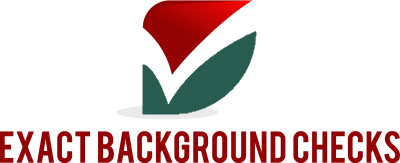The Timeline of Drug Test Results Explained

Introduction to Drug Testing and Timeline Expectations
Drug test is a standard practice in various industries, used to detect the presence of substances in a person’s system. Whether it’s for employment, legal, or medical purposes, drug testing serves as a critical tool to ensure safety, compliance, and productivity. In this article, we will delve into the topic of drug testing timelines, exploring how long drug test results take to process and what factors influence these timeframes.
What Is Drug Testing?
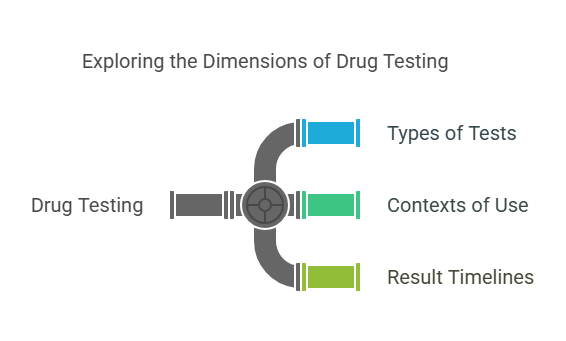
Drug testing involves the collection and analysis of biological samples to detect the presence of drugs or other substances. There are several types of drug tests, including urine tests, blood tests, saliva tests, and hair follicle tests, each with its own method of collection and analysis. Drug testing is commonly used to assess whether someone has been using drugs recently or over an extended period of time.
Drug testing can be performed in a variety of contexts, and the timeline for receiving results varies based on the type of test, the substances being tested for, and the specific circumstances surrounding the test. Let’s explore the different scenarios in which drug testing is used and what can be expected in terms of result timelines.
Purpose of Drug Testing
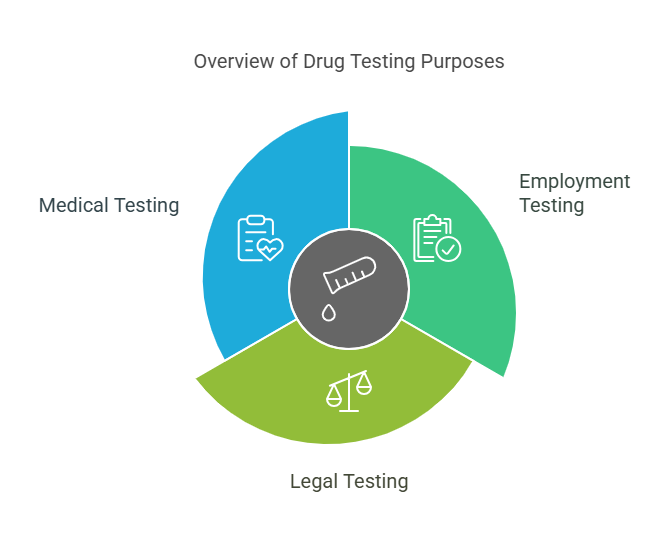
Drug testing serves several key purposes, depending on the context in which it is being conducted:
- Employment Testing: Many employers require pre-employment drug testing to ensure potential hires are not using illegal substances. Employers may also conduct random drug tests or post-accident testing to maintain a safe, productive workplace.
- Legal Testing: Drug testing may be used in legal situations, such as probation, child custody hearings, or DUI cases. In these instances, the test results may play a role in determining legal outcomes.
- Medical Testing: Drug testing is often used in medical settings to monitor patients for substance abuse, to help guide treatment plans, or as part of routine screenings for certain health conditions.
How Long Does Drug Testing Take?
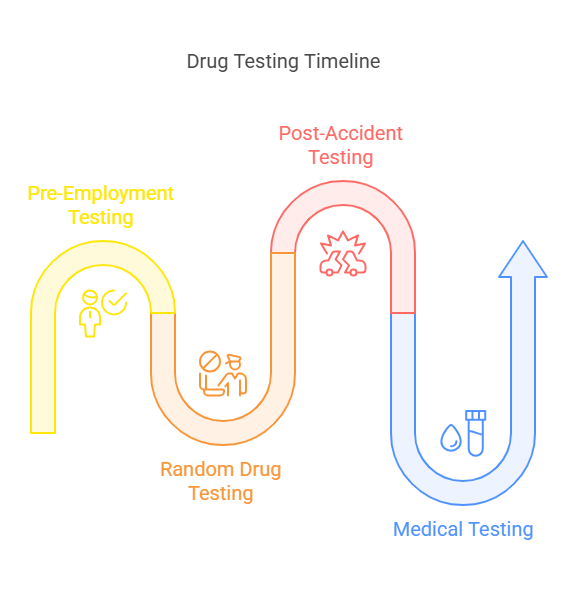
The amount of time it takes to receive drug test results depends on several factors, such as the type of test, the substances being tested for, and the testing facility’s processing times. The timeline can range from a few minutes to several days or even weeks, depending on the test type and method used for analysis. Understanding the expectations for each type of test will help both employers and employees manage timelines effectively.
General Timeline Expectations for Different Scenarios
- Pre-Employment Testing: Many companies require drug tests as part of the hiring process. The results for pre-employment drug tests are typically available within 24 to 72 hours, depending on the test type and laboratory processing speed. Most employers expect to receive results within this timeframe to make quick hiring decisions.
- Random Drug Testing: Random drug tests are often conducted by employers as part of ongoing workplace safety programs. Results from random testing can take anywhere from 1 to 3 days for most common tests (urine, saliva), but some tests, like hair follicle tests, may take longer.
- Post-Accident Testing: When an accident occurs in the workplace, employees may be asked to take a drug test to determine if drug use was a factor in the incident. These tests are generally processed quickly to help assess whether drugs or alcohol played a role in the accident. Results for post-accident testing are typically available within 24 to 72 hours, depending on the test.
- Medical Testing: For medical purposes, the timeline for drug test results can vary based on the type of drug and the purpose of the test. Routine drug screenings often provide results in 1 to 3 days, but tests for specific substances or conditions may take longer, particularly if the sample needs to be sent to a specialized laboratory for further analysis.
Factors That Influence Drug Test Result Timelines
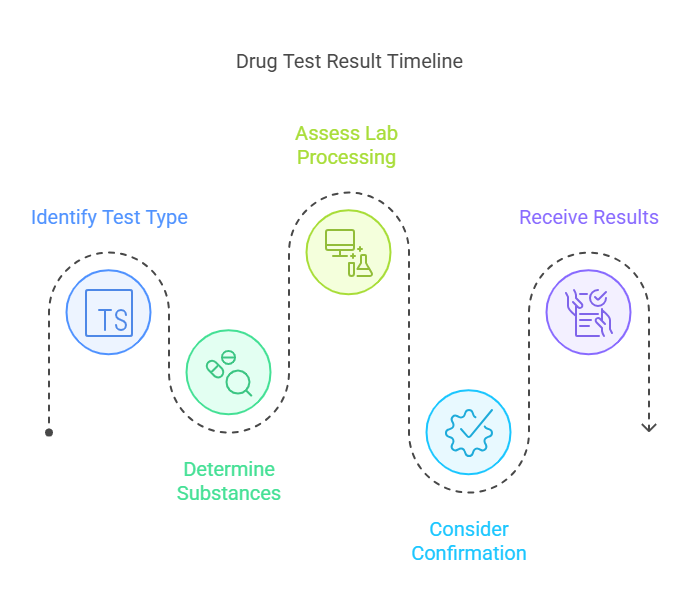
The time it takes to receive drug test results depends on several factors, including the type of test being performed, the substances being tested for, and the laboratory processing the results. Let’s break down these factors in more detail:
1. Type of Drug Test
The method of drug testing used can significantly impact how long it takes to receive results. Below are some common types of drug tests and the typical timeframes for each:
- Urine Drug Test: Urine tests are the most commonly used method for drug testing. They are quick, relatively inexpensive, and provide reliable results for detecting recent drug use. Results for urine drug tests are usually available within 1 to 3 days.
- Saliva Drug Test: Saliva tests are non-invasive and can be performed quickly, making them popular for on-site testing. Saliva drug tests can typically provide results within minutes to a few hours, depending on the testing procedure.
- Blood Drug Test: Blood tests are the most accurate but also the most invasive and expensive. They are typically used in situations where precise information about drug levels in the bloodstream is required, such as in medical or legal contexts. Blood test results can take anywhere from 1 to 7 days, depending on the complexity of the test and laboratory processing time.
- Hair Follicle Drug Test: Hair follicle tests are used to detect drug use over an extended period (up to 90 days). They are highly accurate but require more time to process compared to other tests. Hair follicle test results usually take 3 to 7 days to process, but in some cases, it may take up to 10 days, especially if the test is sent to a specialized laboratory for analysis.
2. Substances Being Tested For
The specific substances being tested for can also influence how long it takes to receive drug test results. Some drugs are easier to detect and metabolize faster, while others may require more extensive testing or processing time.
- Common Substances: Tests for common substances like marijuana, cocaine, or opioids can typically provide faster results, particularly if the test is performed using a urine or saliva sample.
- Specialized Drugs: If the test is looking for less common or more complex substances (e.g., synthetic drugs or certain prescription medications), additional laboratory testing or confirmatory tests (such as Gas Chromatography-Mass Spectrometry, or GC-MS) may be required. These tests can lengthen the processing time, sometimes extending results by several days.
3. Laboratory Processing Times
The laboratory where the drug test is conducted also plays a significant role in the timeline. Some laboratories have faster processing times and can produce results in just a day or two, while others may take longer, especially if the sample needs to be sent to a secondary lab for more specialized testing.
- On-Site Testing: Some employers or testing facilities use on-site testing kits, which can provide immediate or near-immediate results for drugs like marijuana, cocaine, or opiates.
- Third-Party Labs: If the sample is sent to a third-party laboratory, the processing time can be longer, typically between 1 to 7 days, depending on the complexity of the test and the laboratory’s workload.
4. Testing Method and Confirmation Procedures
In some cases, a positive drug test result may require confirmation through a more detailed analysis, which can extend the overall timeline. For example, initial urine tests may be followed up with a confirmatory test using GC-MS or liquid chromatography-mass spectrometry (LC-MS) if the results are ambiguous or show the presence of certain substances.
Confirmatory testing ensures the accuracy of the results but can add 1 to 3 additional days to the timeline.
Factors Affecting the Speed of Drug Test Results and Services
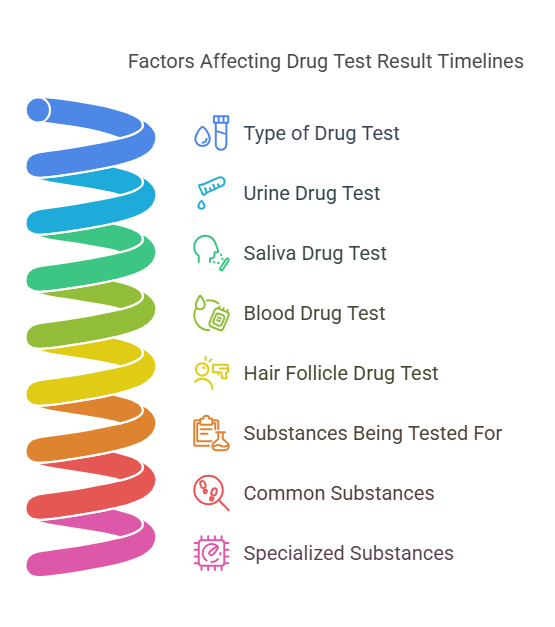
We explored the various contexts in which drug testing is performed and the general timelines for receiving drug test results. Now, let’s dive deeper into the factors that impact the speed of drug test results. Understanding these factors will help both employers and employees set expectations and ensure that the process is as efficient as possible. Additionally, we will look at services like Exact Background Checks, which specialize in streamlining the drug testing process to provide timely and accurate results.
1. Type of Drug Test
The type of drug test administered plays a significant role in determining how long it takes to receive results. There are several common methods for drug testing, and each comes with its own timeline for processing and reporting results.
Urine Drug Test (UDT)
Urine drug tests are the most widely used and least invasive method of drug testing. These tests are designed to detect recent drug use and are effective at identifying substances that remain in the body for several days to weeks, such as marijuana, cocaine, opiates, and methamphetamines.
- Typical Timeline: Urine drug tests generally provide results within 24 to 72 hours. Most employers or testing centers expect to have the results within 1 to 3 days.
- Why the Timeline Varies: The timeline for urine tests can vary based on the testing facility’s workload, the complexity of the substances being tested for, and the need for confirmatory testing. Some laboratories may take longer to process urine samples, particularly if the test results are inconclusive or require further analysis.
Saliva Drug Test
Saliva drug tests are gaining popularity due to their non-invasive nature and quick processing times. Saliva tests are most commonly used for detecting recent drug use (within the last 24 to 48 hours) and are typically administered on-site, making them an attractive option for employers conducting random or post-accident testing.
- Typical Timeline: Saliva drug tests can provide results almost immediately or within 15 to 30 minutes for on-site testing. However, if the sample is sent to a laboratory for more detailed analysis, the processing time can extend to 1 to 2 days.
- Why the Timeline Varies: Saliva tests are usually performed on-site and give quick results, making them ideal for scenarios where rapid testing is necessary. However, if the test results are ambiguous or if a more sensitive method (such as a urine or blood test) is needed for confirmation, it may take longer to process.
Blood Drug Test
Blood drug tests are highly accurate and are commonly used in medical and legal situations. They detect the presence of drugs in the bloodstream and are typically used for verifying impairment at the time of testing (e.g., for DUI testing or when a precise measurement of drug concentration is required).
- Typical Timeline: Blood test results can take 1 to 7 days to process. The time frame depends on the complexity of the test and the laboratory’s processing times.
- Why the Timeline Varies: Blood tests require specialized laboratory analysis and can take longer because the blood sample must be handled with care, and the substances must be precisely measured. Additionally, the complexity of certain tests, such as those testing for a wide range of substances or drugs that take longer to metabolize, may further extend the timeline.
Hair Follicle Drug Test
Hair follicle testing is used to detect drug use over an extended period, typically up to 90 days. This test works by analyzing the hair shafts for drug metabolites that are absorbed from the bloodstream into hair follicles. It is commonly used for pre-employment screenings or in legal cases where long-term drug use is a concern.
- Typical Timeline: Hair follicle test results can take between 3 to 7 days to be processed. In some cases, results may be delayed, especially if the test is sent to a specialized lab or if there is a backlog in processing.
- Why the Timeline Varies: Hair tests take longer because the sample collection is more invasive, and the analysis is more intricate than other methods. Furthermore, hair tests require specialized equipment to analyze drug metabolites in the hair, and the lab may need additional time to ensure accurate results.
2. Substances Being Tested For
The substances being tested for also affect the timeline of the drug testing process. Some substances are easier to detect and can be identified quickly, while others require more sensitive testing methods that take longer to analyze. Additionally, some drugs stay in the system for a longer period, which can influence testing methods and processing times.
Common Substances
Drugs such as marijuana, cocaine, opiates, and methamphetamines are common targets of drug tests and are generally detected quickly in urine or saliva tests. These drugs are metabolized relatively quickly and leave the body in a shorter timeframe, making their detection faster in the sample.
- Typical Timeline: For common substances, results for urine or saliva tests can usually be obtained within 1 to 3 days. If blood or hair testing is required, it may take longer, depending on the drug and the type of test used.
Specialized Substances
Drugs such as synthetic cannabinoids, prescription medications (e.g., benzodiazepines), and rare illicit drugs may require more extensive testing. These substances can sometimes go undetected by standard screening methods, so confirmatory tests such as Gas Chromatography-Mass Spectrometry (GC-MS) or High-Performance Liquid Chromatography (HPLC) may be necessary. These methods are more sensitive but require more time to complete.
- Typical Timeline: Tests for specialized substances often take 3 to 7 days or longer, depending on the complexity of the substances being tested and the laboratory’s equipment. Confirmatory tests and the need for additional verification can increase the processing time.
3. Laboratory Processing Times
The laboratory processing time is one of the most significant factors that can impact the speed at which drug test results are reported. Not all testing laboratories are the same, and the speed of result processing can vary depending on the laboratory’s efficiency, workload, and type of test being conducted.
On-Site vs. Third-Party Laboratories
- On-Site Testing: Some employers or testing centers use on-site testing kits, which can quickly provide initial results for substances like marijuana, cocaine, and opiates. On-site testing allows for results within 15 to 30 minutes, depending on the testing method. However, these results are generally considered preliminary and may need to be confirmed through a laboratory test if the initial results are positive.
- Third-Party Laboratories: When samples are sent to third-party laboratories for testing, the process can take longer. Third-party laboratories generally take 1 to 7 days to process and provide results. The time frame can vary depending on the complexity of the drug being tested for, the number of tests being conducted, and the laboratory’s current workload.
4. Testing Method and Confirmation Procedures
In some cases, drug test results may require further analysis or confirmation before they are finalized and reported. This is especially true if the initial test shows a positive result or if the results are inconclusive.
- Confirmatory Testing: If a preliminary test (e.g., a urine test) returns a positive result, a confirmatory test (such as GC-MS or LC-MS) is often required to ensure accuracy. These confirmatory tests are highly precise but can add 1 to 3 days to the overall timeline.
- Chain of Custody: The integrity of the sample must be maintained throughout the testing process to ensure the results are valid. The chain of custody involves proper handling, tracking, and documentation of the sample to prevent tampering or contamination. If the chain of custody is broken or if there are discrepancies in sample handling, the process may be delayed as the sample may need to be retested.
5. Exact Background Checks and Timely Drug Testing Services
At Exact Background Checks, we understand the importance of timely and accurate drug testing, especially in high-stakes environments such as pre-employment screenings and random drug tests for safety-sensitive positions. We work with accredited laboratories and use state-of-the-art technology to ensure fast turnaround times without compromising the accuracy or reliability of the results.
How Exact Background Checks Streamlines the Process
- Quick Turnaround: By partnering with reputable laboratories and utilizing advanced testing methods, Exact Background Checks can ensure that the majority of drug tests are completed within 1 to 3 days for common substances (urine and saliva tests). Hair follicle and blood tests may take a bit longer, but we strive to provide results as quickly as possible.
- Efficient Communication: We prioritize transparency and communication throughout the process, keeping employers and individuals informed about the status of their tests. With Exact Background Checks, you will receive prompt notifications when results are available, allowing you to proceed with your hiring or safety protocols without unnecessary delays.
